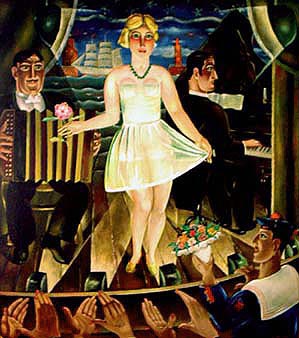Reimond Kimpe
1885 – 1970
Reimond Kimpe was born on December 8,1885 in Gent, Belgium.
Kimpe began his career as an engineer. From 1918 to 1923 he worked on
building projects in Middelburg, a town in the southern province of
Zeeland, The Netherlands. Kimpe and Albert Servaes were friends since
their schooldays. It was Servaes who introduced Kimpe to the St. Martens
Laethem School. Kimpe together with Frits Van Den Berghe and Gustave
de Smet wrote the manifesto “Vie et Lumière” against
the Luminists.
In 1923 Kimpe became ill and consequently abandoned his work as an engineer.
While in recovery he dedicated himself to painting, which became his
life’s work.
Kimpe’s most prolific period was during World War II, between
1939 and 1945. This productivity was a result of the early bombings
that devastated the town of Middelburg including his studio and over
200 hundred paintings. After the bombings he became more and more reclusive.
This solitude was of great artistic benefit to Kimpe because he escaped
the cruel restrictions that the Nazi’s imposed on other artists.
As a result of the Nazi’s regulations, several of Kimpe’s
friends deserted their art practices.
Many of his paintings illustrate his interest in the sea and seafaring
paraphernalia. All of his paintings are deeply symbolic. “Cabaret,”
surely one of his masterpieces, combines many nautical elements in a
bizarre nightclub scene. Kimpe’s style brings together all of
the romance, mystery, and technical excellence of the Belgian Expressionists.
Kimpe’s paintings were first shown in 1922 at the Den Haag Kunstzaal
Toorop and then in 1924 at the Middelburg Kunstmuseum. Kimpe exhibited
his works almost every year in Belgium and the Netherlands. He showed
his work in 1930 at La Galerie Themis in Belgium. Kimpe lived in Paris
for a time beginning in 1929, in1931 and 1932 he exhibited with the
Surindéndants. It was in this period he met Picasso and Chagall.
In 1942 he exhibited at the Frans Hals Museum in Haarlem and in 1962
in Antwerp at the C.A.W. aan de Meir. He exhibited throughout his career
in his hometown of Middelburg, including many exhibitions at the Middelburg
Kunstmuseum. He also showed his works at the Middelburg Vleeshal and
the Middelburg Studio.
Kimpe’s exhibitions in Holland included the Amsterdam Stedelijk
Museum and the Amsterdam Rijksmuseum. He also exhibited at the Het Prisonhof
in Delft in 1952.
In 1951 Winants HeerlenIn published an illustrated monograph on Kimpe.
1972 Joos Florquin published a finely illustrated book on Kimpe’s
work. A 1997 major retrospective exhibition held at the Singer Museum
in Laren traveled to the Zeeuws Museum in Middelburg. An extensive catalogue
with many color illustrations complemented the retrospective.
Kimpe’s works have been acquired by many museums including the
Musée d’Art Moderne de la Ville de Paris, Museum Boymans
in Rotterdam, Museum voor Schone Kunsten in Antwerp, Zeeuws Museum in
Middelburg, and the Museo dell’Arte Moderno in Caracas.
After a career that spanned four decades Kimpe died in 1970.
|

